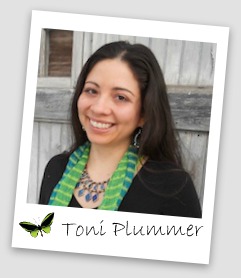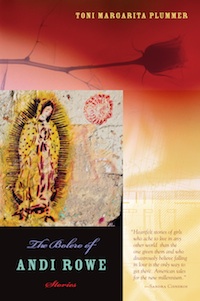 ~ Interview By Alana Albertson
~ Interview By Alana Albertson
I was first introduced Toni Plummer in 2006 at Alisa Valdes Rodriguez’s Chica Lit Conference in Miami. We bonded over Mojitos and salsa dancing and have over the year met up for dessert and country line dancing. Not only is she a brilliant editor at St. Martins (she edited one of my favorite books, Living the Vida Lola by Misa Ramirez) she is a writer and a former Stiletto Contest judge. Her first book is a tragically beautiful collection of short stories that touched my soul.
Please welcome Toni to our blog!
Q: What inspired you to write a group of short stories as opposed to a novel?
 A: What I wanted to do was write about many small moments that, added up, painted a kind of portrait of a family and a community. I first tried to write the book as a novel, but what I ended up with were many disconnected scenes, not a true novel. Writing a short story collection allowed me to focus on what I wanted, without having to tie everything together so directly. I’m also a big fan of short stories–I love the power they can pack.
A: What I wanted to do was write about many small moments that, added up, painted a kind of portrait of a family and a community. I first tried to write the book as a novel, but what I ended up with were many disconnected scenes, not a true novel. Writing a short story collection allowed me to focus on what I wanted, without having to tie everything together so directly. I’m also a big fan of short stories–I love the power they can pack.
Q: How did your experiences as a bi racial (Mexican mother, Anglo father) Mexican-American influence your writing?
A: I think my experience growing up was very different than that of my friends, who came from almost completely Mexican backgrounds. In college, I did make some other friends with backgrounds more similar to mine. Both sides of my heritage were special to me, and so when I began to write these stories I set out to write about a character with similar family dynamics–I just found it more complex and interesting.
Q: How does your day job (editor at St. Martin’s) help/hurt your writing?
A: As with any job, it takes time away from writing. Being an editor isn’t a 9-5 job. It’s a big investment of time and energy. On the other hand, I’m constantly reading submissions, editing, and talking about novels. This has trained me to regard my own work more objectively. Also, my authors are truly amazing and their work habits and promotional efforts inspire me. I’m very fortunate to be in a position where I work with and come across authors all the time. It’s given me a much better grasp of what the life of an author is like and what it takes to be successful at it.
Q: Your stories are beautifully bound to the rich settings surrounding the characters – which is a challenge for many writers. Did you choose to write stories based on the setting or did you choose landscapes that best suited your stories?
A: I knew that I wanted to write stories set in my hometown and the greater Los Angeles area, because it’s what I knew and I found a lot of inspiration there. I think that before I could write about anywhere else I had to capture my feelings and awe for these places. I also knew what the stories and characters would be though, so you could say those came first. The stories were always very much bound to the places. One couldn’t exist without the other.
Q: If you were assigned to teach a course at a college on Chica lit, which 5 books(any genre) would you assign and why?
A: Fun!
- THE DIRTY GIRLS SOCIAL CLUB by Alisa Valdes-Rodriguez. You couldn’t teach a class about Chica lit without discussing this book. It was wildly different than anything before it, and it got a lot of interest from publishers, critics, and readers. It’s an entertaining and intelligent look at female friendship that I think all readers of literature about Latinas should be familiar with.
- MIDNIGHT AT CASA DRACULA by Marta Acosta, for its interesting take on the vampire novel and its sense of humor.
- JUICY MANGOS, edited by Michelle Herrera Mulligan. This was the first English-language erotica collection written by Latinas, and it gives insight into a big part of our identity, our sexuality.
- THE ACCIDENTAL SANTERA by Irete Lazo. This first novel gives a touching portrayal of how one modern woman comes to integrate religious beliefs into her life, and the role her family and culture play in that.
- DEATH AT SOLSTICE by Lucha Corpi. This mystery features a Chicana detective and does a wonderful job of weaving in California history and Mexican folklore.
There are many, many more books of course, but this list gives a good sampling of different genres and would lead to interesting discussions on family, relationships, politics, career, and spirituality.
Q: What are you looking for in submissions?
A: I’m looking for engaging fiction with strong female characters. Plot is very important, no matter what genre. I tend to like novels with humor.
Thank you so much for visiting the blog today, Toni!

